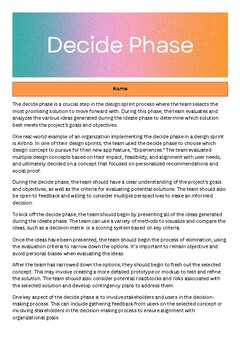Design Sprint: Decide Phase Reading Comprehension
12 Downloads
thomas levy
1 Follower
Grade Levels
9th - 12th
Subjects
Resource Type
Standards
CCSSRI.9-10.1
CCSSCCRA.R.10
CCSSRST.9-10.9
NGSSHS-ESS3-2
NGSSHS-ESS3-4
Formats Included
- PDF
Pages
2 pages
thomas levy
1 Follower
Description
This reading comprehension activity teaches the Decide Phase of the Design Sprint framework that is used by Google and other companies to launch new products. Great for students studying business or UX Design.
Total Pages
2 pages
Answer Key
Not Included
Teaching Duration
30 minutes
Report this resource to TPT
Reported resources will be reviewed by our team. Report this resource to let us know if this resource violates TPT’s content guidelines.
Standards
to see state-specific standards (only available in the US).
CCSSRI.9-10.1
Cite strong and thorough textual evidence to support analysis of what the text says explicitly as well as inferences drawn from the text.
CCSSCCRA.R.10
Read and comprehend complex literary and informational texts independently and proficiently.
CCSSRST.9-10.9
Compare and contrast findings presented in a text to those from other sources (including their own experiments), noting when the findings support or contradict previous explanations or accounts.
NGSSHS-ESS3-2
Evaluate competing design solutions for developing, managing, and utilizing energy and mineral resources based on cost-benefit ratios. Emphasis is on the conservation, recycling, and reuse of resources (such as minerals and metals) where possible, and on minimizing impacts where it is not. Examples include developing best practices for agricultural soil use, mining (for coal, tar sands, and oil shales), and pumping (for petroleum and natural gas). Science knowledge indicates what can happen in natural systems—not what should happen.
NGSSHS-ESS3-4
Evaluate or refine a technological solution that reduces impacts of human activities on natural systems. Examples of data on the impacts of human activities could include the quantities and types of pollutants released, changes to biomass and species diversity, or areal changes in land surface use (such as for urban development, agriculture and livestock, or surface mining). Examples for limiting future impacts could range from local efforts (such as reducing, reusing, and recycling resources) to large-scale geoengineering design solutions (such as altering global temperatures by making large changes to the atmosphere or ocean).



